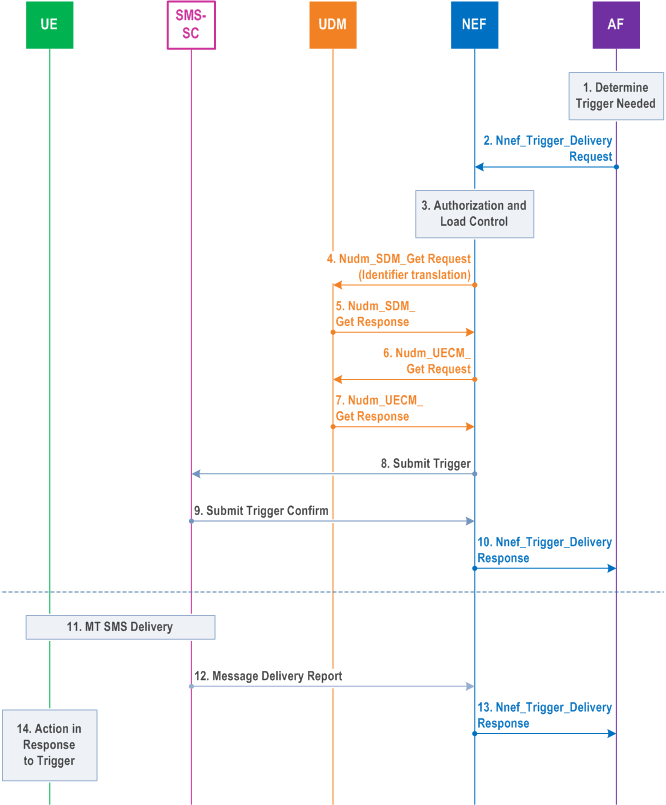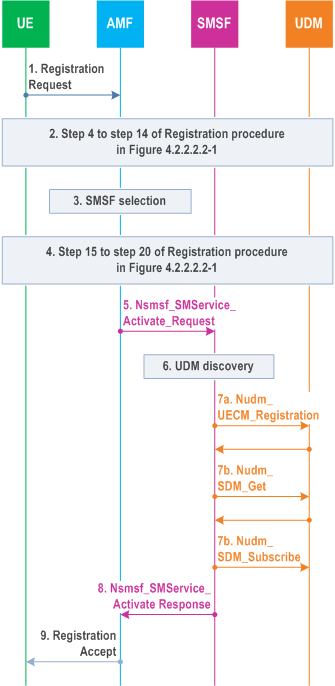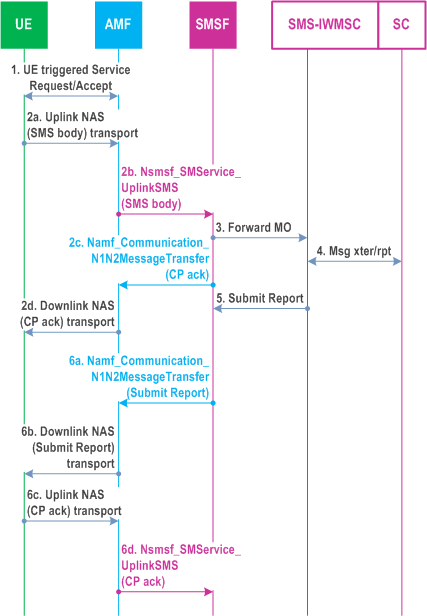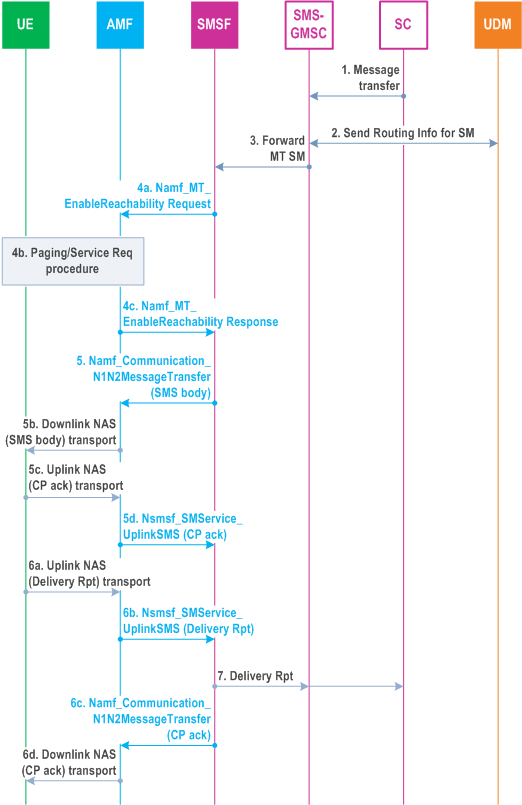Content for TS 23.502 Word version: 19.2.0
1…
4.2.2.2.2
4.2.2.2.3…
4.2.2.3…
4.2.3…
4.2.3.3
4.2.4…
4.2.6
4.2.7…
4.2.9…
4.2.11…
4.2.11.5…
4.3…
4.3.2.2.2
4.3.2.2.3…
4.3.3…
4.3.3.3
4.3.4…
4.3.4.3
4.3.5…
4.3.5.2…
4.3.5.4…
4.3.5.6…
4.3.6…
4.4…
4.5…
4.9…
4.9.1.3…
4.9.2…
4.11…
4.11.1…
4.11.1.2.2
4.11.1.2.3
4.11.1.3…
4.11.1.3.3…
4.11.1.4…
4.11.1.5…
4.11.2…
4.11.3…
4.12…
4.12.6…
4.12a…
4.12b…
4.13…
4.13.4…
4.13.6…
4.14…
4.15…
4.15.3.2.5…
4.15.4…
4.15.6…
4.15.6.7…
4.15.6.13…
4.15.6.14…
4.15.9…
4.15.9.4…
4.15.13…
4.15.13.4…
4.16…
4.16.4…
4.16.8…
4.16.11…
4.16.14…
4.16.15…
4.17…
4.17.9…
4.18…
4.19…
4.22…
4.23…
4.23.7…
4.23.7.3.3
4.23.7.3.4…
4.23.9…
4.23.9.4…
4.23.11…
4.24…
4.25…
4.25.6…
4.26…
5…
5.2.3…
5.2.5…
5.2.6…
5.2.7…
5.2.8…
5.2.9…
5.2.12…
5.2.18…
A…
E…
F…
G
H…
4.13 Specific services
4.13.1 General
4.13.2 Application Triggering
4.13.2.1 General
4.13.2.2 The procedure of "Application Triggering" Service
4.13.3 SMS over NAS procedures
4.13.3.1 Registration procedures for SMS over NAS
4.13.3.2 Deregistration procedures for SMS over NAS
4.13.3.3 MO SMS over NAS in CM-IDLE (baseline)
4.13.3.5 MO SMS over NAS in CM-CONNECTED
4.13.3.6 MT SMS over NAS in CM-IDLE state and RRC_INACTIVE with CN based MT communication state via 3GPP access
4.13.3.7 MT SMS over NAS in CM-CONNECTED state via 3GPP access
4.13.3.8 MT SMS over NAS via non-3GPP access
4.13.3.9 Unsuccessful Mobile terminating SMS delivery re-attempt
...
...
4.13 Specific services p. 372
4.13.1 General p. 372
Clause 4.13 defines the additional procedures or additions to the existing procedures to support specific services such as SMS over NAS.
4.13.2 Application Triggering p. 372
4.13.2.1 General p. 372
The AF invokes the Nnef_Trigger service to request that the network send an Application trigger to the UE.
4.13.2.2 The procedure of "Application Triggering" Service p. 373

Step 1.
The AF determines the need to trigger the device. If the AF has no contact details for the NEF, it shall discover and select NEF services.
Step 2.
The AF invokes the Nnef_Trigger_Delivery request service.
Step 3.
The NEF checks that the AF is authorised to send trigger requests and that the AF has not exceeded its quota or rate of trigger submission over Nnef. If this check fails, the NEF sends an Nnef_Trigger_Delivery response with a cause value indicating the reason for the failure condition and the flow stops at this step. Otherwise, the flow continues with step 4.
Step 4.
The NEF invokes Nudm_SDM_Get (Identifier Translation, GPSI and AF Identifier) to resolve the GPSI to SUPI when the AF is authorized to trigger the UE.
Step 5.
The UDM may invoke the Nudr_DM_Query service to retrieve a list of AF's that are allowed to trigger the UE and determines, based on UDM policy, which identifier (SUPI or MSISDN) should be used to trigger the UE. The UDM provides a Nudm_SDM_Get response (SUPI, optionally MSISDN. If the AF is not allowed to send a trigger message to this UE, or there is no valid subscription information for this user, the NEF sends an Nnef_Trigger_Delivery response with a cause value indicating the reason for the failure condition and the flow stops at this step. Otherwise this flow continues with step 6.
Step 6.
The NEF invokes Nudm_UECM_Get (GPSI, SMS) to retrieve the UE SMSF identities.
Step 7.
The UDM may invoke the Nudr_DM_Query service to retrieve the UE SMSF identities. The UDM provides a Nudm_UECM_Get response with the corresponding UE SMSF identities. UDM policy (possibly dependent on the VPLMN ID) may influence which serving node identities are returned.
Step 8.
The NEF selects a suitable SMS-SC based on configured information. The NEF acts as an MTC-IWF and sends a Submit Trigger (GPSI, SUPI, AF Identifier, trigger reference number, validity period, priority, SMSF serving node ID(s) (if available, are obtained from UDM in step 7), SMS Application port ID, trigger payload, Trigger Indication) message to the SMS-SC.
If the NEF indicates that "Absent subscriber" was received from the UDM, the SMS-SC should not submit the message, but store it directly and send Routing Information for SM to request the UDM to add the SMS-SC address to the Message Waiting List.
Step 9.
The SMS-SC sends a Submit Trigger Confirm message to the NEF to confirm that the submission of the SMS has been accepted by the SMS-SC.
Step 10.
The NEF sends a Nnef_Trigger_Delivery response to the AF to indicate if the Device Trigger Request has been accepted for delivery to the UE.
Step 11.
The SMS_SC performs MT SMS delivery as defined in clause 4.13.3. The SMS-SC may provide the routing information that it received in step 6 to SMS-GMSC to avoid UDM interrogation. The SMS-SC generates the necessary CDR information and includes the AF Identifier. The SMS Application port ID, which is included in the SM User Data Header and the Trigger Indication are included in the CDRs in order to enable differentiated charging. The SMS-SC stores the trigger payload, without routing information. If the message delivery fails and is attempted to be delivered again, UDM interrogation will be performed. If the message delivery fails and the validity period of this trigger message is not set to zero, the SMS-SC shall send a SM Message Delivery Status Report to request the UDM to add the SMS-SC address to the Message Waiting list. When the message delivery is later re-attempted, a new UDM interrogation will be performed by the SMS-GMSC using SUPI or MSISDN. UDM interrogations using SUPI shall not be forwarded or relayed to SMS-Router or IP-SM-GWs. The UDM may include up to four serving node identities (MSC or MME, SGSN, IP-SM-GW, AMF) in the response to SMS-GMSC.
Step 12.
If the message delivery fails (either directly or when validity period of the trigger message expires) or when the message delivery succeeds, the SMS-SC shall send a Message Delivery Report (cause code, trigger reference number, AF Identifier) to the NEF.
Step 13.
The NEF provides a Nnef_Trigger_DeliveryNotify message to the AF with a Delivery Report indicating the trigger delivery outcome (e.g. succeeded, unknown or failed and the reason for the failure). The NEF generates the necessary CDR information including the GPSI and AF Identifier.
Step 14.
In response to the received device trigger, the UE takes specific actions and may take into consideration the content of the trigger payload. This action typically involves initiation of immediate or later communication with the AF.
4.13.3 SMS over NAS procedures p. 375
4.13.3.1 Registration procedures for SMS over NAS p. 375

Step 1.
During Registration procedure in 5GS defined in Figure 4.2.2.2.2-1, to enable SMS over NAS transporting, the UE includes an "SMS supported" indication in Registration Request in step 1-3 indicating the UE's capability for SMS over NAS transport. The "SMS supported" indication indicates whether the UE supports SMS delivery over NAS.
Step 2.
Step 4 to step 14 of the Registration procedure in Figure 4.2.2.2.2-1 are performed. The AMF may retrieve the SMS Subscription data and UE Context in SMSF data using Nudm_SDM_Get . This requires that UDM may retrieve this information from UDR by Nudr_DM_Query . The UDM includes the SMSF information in the Nudm_SDM_Get response message if the stored SMSF belongs to the same PLMN of the AMF. After a successful response is received and if SMS service is allowed, the AMF subscribes to be notified using Nudm_SDM_Subscribe when the SMS Subscription data is modified and UDM may subscribe to UDR by Nudr_DM_Subscribe . For an MPS-subscribed UE, the subscription data may include the MPS priority for Messaging indication. If the AMF receives the MPS for Messaging indication from UDM, the AMF stores the MPS for Messaging indication in the UE context.
The AMF can also receive UE context information containing SMSF Information from old AMF. When AMF re-allocation happens during the Registration procedure, the old AMF transfers SMSF Information to the new AMF as part of UE context in step 5 of Figure 4.2.2.2.2-1.
Step 3.
If the "SMS supported" indication is included in the Registration Request, the AMF checks in the SMS Subscription data that was received in step 2 whether the SMS service is allowed to the UE. If SMS service is allowed and the UE context received in step 2 includes an available SMSF of the serving PLMN, the AMF activates this SMSF Address and continues the registration procedure. If SMS service is allowed but an SMSF of the serving PLMN was not received in step 2, the AMF discovers and selects an SMSF to serve the UE as described in clause 6.3.10 of TS 23.501.
Step 4.
Step 15 to step 20 of the Registration procedure in Figure 4.2.2.2.2-1 are performed.
Step 5.
The AMF invokes Nsmsf_SMService_Activate service operation from the SMSF. The invocation includes AMF address, Access Type, RAT Type, Trace Requirements, GPSI (if available) and SUPI. AMF uses the SMSF Information derived from step 3. Trace Requirements is provided if it has been received by AMF as part of subscription data. When the AMF determines the UE has the MPS for Messaging indication in UE context as specified in step 2, the AMF includes a Message Priority header with a value appropriate for MPS to indicate priority treatment.
Step 6.
The SMSF discovers a UDM as described in clause 6.3.8 of TS 23.501.
Step 7a.
If the UE context for the current Access Type already exists in the SMSF, the SMSF shall replace the old AMF address with the new AMF address.
Otherwise, the SMSF considers this a Registration request from a new Access Type and the SMSF registers with the UDM using Nudm_UECM_Registration with Access Type. As a result, the UDM stores the following information: SUPI, SMSF identity, SMSF address, Access Type(s) in UE Context in SMSF data. The UDM may further store SMSF Information in UDR by Nudr_DM_Update (SUPI, Subscription Data, UE Context in SMSF data).
If the Nsmsf_SMService_Activate request contains two Access Types and one of them is already registered in the SMSF, the SMSF shall replace the old AMF address with the new AMF address for that Access Type. The SMSF shall then register the other Access Type with the UDM using Nudm_UECM_Registration request.
Step 7b-7c.
SMSF retrieves SMS Management Subscription data (e.g. SMS teleservice, SMS barring list) using Nudm_SDM_Get and this requires that UDM may get this information from UDR by Nudr_DM_Query (SUPI, Subscription Data, SMS Management Subscription data). After a successful response is received, the SMSF subscribes to be notified using Nudm_SDM_Subscribe when the SMS Management Subscription data is modified and UDM may subscribe to notifications from UDR by Nudr_DM_Subscribe .
SMSF also creates a UE context to store the SMS subscription information and the AMF address that is serving this UE.
Step 8.
The SMSF responds back to the AMF with Nsmsf_SMService_Activate service operation response message. The AMF stores the SMSF Information received as part of the UE context.
Step 9.
The AMF includes the "SMS allowed" indication to the UE in the Registration Accept message of step 21 of Figure 4.2.2.2.2-1 only after step 8 in which the AMF has received a positive indication from the selected SMSF.
The "SMS allowed" indication in the Registration Accept message indicates to the UE whether the network allows the SMS message delivery over NAS.
4.13.3.2 Deregistration procedures for SMS over NAS p. 376
If UE indicates to AMF that it no longer wants to send and receive SMS over NAS (e.g. not including "SMS supported" indication in subsequent Registration Request message) or AMF considers that UE is deregistered on specific Access Type(s) or AMF receives Deregistration Notification from UDM for specific Access Type(s) indicating UE Initial Registration, Subscription Withdrawn or 5GS to EPS Mobility as specified in clause 5.2.3.2.2, then:
-
AMF may, if the UE is not registered at other Access Type at the AMF any more, unsubscribe from SMS Subscription data changes notification with the UDM by means of the Nudm_
SDM_ service operation.Unsubscribe -
AMF invokes Nsmsf_
SMService_ service operation to trigger the release of UE Context for SMS on SMSF for the impacted Access Type(s) based on local configurations.Deactivate - AMF may, if the UE is not registered at other Access Type at the AMF anymore, delete or deactivate the stored SMSF address in its UE Context.
-
The SMSF unsubscribes from SMS Management Subscription data changes notification with the UDM by means of the Nudm_
SDM_ service operation if the UE is not registered at other Access Type for SMS over NAS service at the SMSF anymore.Unsubscribe -
The SMSF shall invoke Nudm_
UECM_ (SUPI, NF ID, Access Type) service operation from UDM to trigger UDM to delete SMSF address of the UE for the impacted Access Type(s). The SMSF also removes the UE Context for SMS for the impacted Access Type(s), including AMF address.Deregistration -
The UDM may update UE context in SMSF in UDR by Nudr_
DM_ (SUPI, Subscription Data, SMS Subscription data, SMSF address). The UDM may remove the corresponding subscription of data change notification in UDR by Nudr_Update DM_ service operation.Unsubscribe
4.13.3.3 MO SMS over NAS in CM-IDLE (baseline) p. 377

Step 1.
The UE performs domain selection for UE originating SMS as defined in clause 5.16.3.8 of TS 23.501 if SMS delivery via non 3GPP access is allowed and possible. If an UE under CM-IDLE state is going to send uplink SMS message, then UE and network perform the UE Triggered Service Request procedure firstly as defined in clause 4.2.3.2 to establish a NAS signalling connection to AMF.
Step 2a.
The UE builds the SMS message to be sent as defined in TS 23.040 (i.e. the SMS message consists of CP-DATA/RP-DATA/TPDU/SMS-SUBMIT parts). The SMS message is encapsulated in an NAS message with an indication indicating that the NAS message is for SMS transporting. The UE send the NAS message to the AMF.
Step 2b.
The AMF forwards the SMS message and SUPI to the SMSF serving the UE over N20 message by invoking Nsmsf_SMService_UplinkSMS service operation. In order to permit the SMSF to create an accurate charging record, the AMF adds the IMEISV, the current UE Location Information (ULI) of the UE as defined in clause 5.6.2 of TS 23.501 and if the UE has sent the SMS via 3GPP access, the local time zone.
When the AMF determines that the UE has the MPS for Messaging indication set (enabled) in the UE context, the AMF includes a Message Priority header to indicate priority information. Other NFs relay the priority information by including the Message Priority header in service-based interfaces, as specified in TS 29.500.
Step 2c.
The SMSF invokes Namf_Communication_N1N2MessageTransfer service operation to forward SMS ack message to AMF.
Step 2d.
The AMF forwards the SMS ack message from the SMSF to the UE using downlink unit data message.
Step 3-5.
The SMSF checks the SMS management subscription data. If SMS delivery is allowed, the procedure defined in TS 23.040 or TS 23.540 applies. If the Message Priority header received in step 2 contains a value that indicates MPS, the SMSF may set the transport priority (e.g. the DRMP) to a value appropriate for MPS.
Step 6a-6b.
The SMSF forwards the submit report to AMF by invoking Namf_Communication_N1N2MessageTransfer service operation which is forwarded to UE via Downlink NAS transport. If the SMSF knows the submit report is the last message to be transferred for UE, the SMSF shall include a last message indication in the Namf_Communication_N1N2MessageTransfer service operation so that the AMF knows no more SMS data is to be forwarded to UE.
If the UE has more than one SMS message to send, the AMF and SMSF forwards SMS /SMS ack/submit report the same way as described in step 2a-6b.
Step 6c-6d.
When no more SMS is to be sent, UE returns a CP-ack as defined in TS 23.040 to SMSF. The AMF forwards the SMS ack message by invoking Nsmsf_SMService_UplinkSMS service operation to SMSF.
4.13.3.4 Void
4.13.3.5 MO SMS over NAS in CM-CONNECTED p. 378
MO SMS in CM-CONNECTED State procedure is specified by reusing the MO SMS in CM-IDLE State without the UE Triggered Service Request procedure.
4.13.3.6 MT SMS over NAS in CM-IDLE state and RRC_INACTIVE with CN based MT communication state via 3GPP access p. 379

Step 1-3.
MT SMS interaction between SC/SMS-GMSC/UDM follow the procedure as defined in TS 23.040 or TS 23.540. If there are two AMFs serving the UE, one is for 3GPP access and another is for non-3GPP access, there are two SMSF addresses stored in UDM/UDR. The UDM shall return both SMSF addresses.
If the MPS for Messaging indication is set for the UE, the UDM may provide the parameter to the SMS-GMSC. If the MPS for Messaging indication from the UDM is set(enabled), or if a priority indication is received with the SMS message from the SC (as in TS 23.272), the SMS-GMSC shall include a Message Priority header (or DRMP) to indicate priority information towards SMSF.
Step 4.
The SMSF checks the SMS management subscription data. If SMS delivery is allowed, SMSF invokes Namf_MT_EnableUEReachability service operation to AMF. AMF pages the UE using the procedure defined in clause 4.2.3.3. The AMF includes Paging Priority if Paging needs to be triggered and the MPS for Messaging indication is stored in the UE context. The UE responds to the page with Service Request procedure.
The AMF shall page with priority:
MT_EnableUEReachability request and pages the UE when UE is considered reachable.
If the UE access to the AMF via both 3GPP access and non-3GPP access, the AMF determines the Access Type to transfer the MT-SMS based on operator local policy.
Step 5a-5b.
- if it receives an MT-SMS from the SMSF and has received an indication that MPS for Messaging is enabled for the UE in the UDM.
- if it receives an MT-SMS from the SMSF with a Message Priority header value used for MPS for Messaging.
SMSF forward the SMS message to be sent as defined in TS 23.040 (i.e. the SMS message consists of CP-DATA/RP-DATA/TPDU/SMS-DELIVER parts) to AMF by invoking Namf_Communication_N1N2MessageTransfer service operation. The AMF transfers the SMS message to the UE.
Step 5c-5d.
The UE acknowledges receipt of the SMS message to the SMSF. For uplink unitdata message toward the SMSF, the AMF invokes Nsmsf_SMService_UplinkSMS service operation to forward the message to SMSF. In order to permit the SMSF to create an accurate charging record, the AMF also includes IMEISV, the current UE Location Information (ULI) of the UE as defined in clause 5.6.2 of TS 23.501 and if the SMS is delivered to the UE via 3GPP access, the local time zone.
Step 6a-6b.
The UE returns a delivery report as defined in TS 23.040. The delivery report is encapsulated in an NAS message and sent to the AMF which is forwarded to SMSF by invoking Nsmsf_SMService_UplinkSMS service operation.
Step 6c-6d.
The SMSF acknowledges receipt of the delivery report to the UE. The SMSF uses Namf_Communication_N1N2MessageTransfer service operation to send SMS CP ack message to the AMF. The AMF encapsulates the SMS message via a NAS message to the UE. If SMSF has more than one SMS to send, the SMSF and the AMF forwards subsequent SMS /SMS ack/ delivery report the same way as described in step 4-6c.
If the SMSF knows the SMS CP ack is the last message to be transferred for UE, the SMSF shall include a last message indication in the Namf_Communication_N1N2MessageTransfer service operation so that the AMF knows no more SMS data is to be forwarded to UE.
Step 7.
4.13.3.7 MT SMS over NAS in CM-CONNECTED state via 3GPP access p. 380
MT SMS in CM-CONNECTED procedure is specified by reusing the MT SMS in CM-IDLE state with the following modification:
- There is no need for the AMF to perform Paging of the UE and can immediate continue with a message to SMSF via N20 to allow the SMSF to start forward the MT SMS.
- When the AMF receives an MT-SMS from the SMSF and has either received an indication that MPS for Messaging is enabled for the UE from the UDM, or has received the MT-SMS with a Message Priority header value used for MPS, the AMF shall include the service priority value (RAN Paging Priority IE as in TS 38.413) appropriate for MPS for Messaging, in the Downlink NAS Transport message sent to the NG-RAN. NG RAN shall use the RAN Paging Priority received from the AMF to page the UE with priority when the UE is in RRC-INACTIVE state.
- If the delivery of the NAS PDU containing the SMS fails e.g. if the UE is in RRC_INACTIVE and NG-RAN paging was not successful, the NG-RAN initiate the UE context release in the AN procedure and provide notification of non-delivery to the AMF. The AMF provides an indication of non-delivery to the SMSF.
4.13.3.8 MT SMS over NAS via non-3GPP access p. 381
MT SMS procedure via non-3GPP access is specified by reusing the MT SMS via 3GPP access in CM-CONNECTED state with the following modification:
- If the UE access to the network via both 3GPP and non-3GPP accesses and the AMF determines to deliver MT-SMS via non-3GPP access based on operator policy in step 4, the NAS messages is transferred via non-3GPP Access Network.
4.13.3.9 Unsuccessful Mobile terminating SMS delivery re-attempt p. 381
The procedure of Unsuccessful Mobile terminating SMS delivery re-attempt is defined as follows:
- For SMS delivery, the SMSF and the UDM support the SMSF and UDM role as specified in TS 23.040.
-
If the UE is registered over both 3GPP access and non-3GPP access in the same AMF (i.e. the UE is registered in the same PLMN for both Access Types):
- if the MT-SMS delivery over one Access Type has failed, the AMF, based on operator local policy, may re-attempt the MT-SMS delivery over the other Access Type before indicating failure to SMSF;
- if the MT-SMS delivery on both Access Types has failed, the AMF shall inform the SMSF immediately.
- If the AMF informs the SMSF that it cannot deliver the MT-SMS to the UE (including the cases that UE applies power saving enhancement as described in step 4 of clause 4.13.3.6), the SMSF sends a failure report to the first SMS-GMSC (which can be co-located with IP-SM-GW or SMS Router) as defined in TS 23.040 or TS 23.540. If the SMS-GMSC has more than one entity for SMS transport towards the UE, then upon receiving MT-SMS failure report, the SMS-GMSC, based on operator local policy, may re-attempt the MT-SMS delivery via the other entity.
- After the first SMS-GMSC informs the UDM/HSS that the UE is not able to receive MT-SMS, the UDM shall set the URRP-AMF flag and store the SC address in the MWD list as defined in TS 23.040 or TS 23.540.
- If the UE is registered in an AMF and the UDM has not subscribed to UE Reachability Notification in the AMF yet, the UDM immediately initiates a subscription procedure as specified in clause 4.2.5.2.
- When the AMF detects UE activities, it notifies UDM with UE Activity Notification as described in clause 4.2.5.3. If the UE is registered in an SMSF, the UDM clears its URRP-AMF flag and the UDM/HSS clears the MWD list and alerts related SCs to retry MT-SMS delivery. Otherwise, if the UE is not registered in an SMSF, the UDM clears its URRP-AMF flag but the UDM/HSS keeps the MWD list to notify the SC upon subsequent SMSF registration for the UE.
-
When the SMS-GMSC requests routing information from UDM/HSS for a UE not registered in 5GC, or for a registered UE which has not been yet registered for SMS service, the UDM/HSS responds to the SMS-GMSC that the UE is absent, stores the SC address in the MWD list (if not yet stored) and indicates that to the SC as defined in TS 23.040 or TS 23.540.
When the UDM receives an Nudm_
UECM_ Request from an SMSF for a UE for which the MWD list is stored and no URRP-AMF flag is set, the UDM/HSS alerts the related SCs to retry the MT-SMS delivery and clears the MWD list.Registration